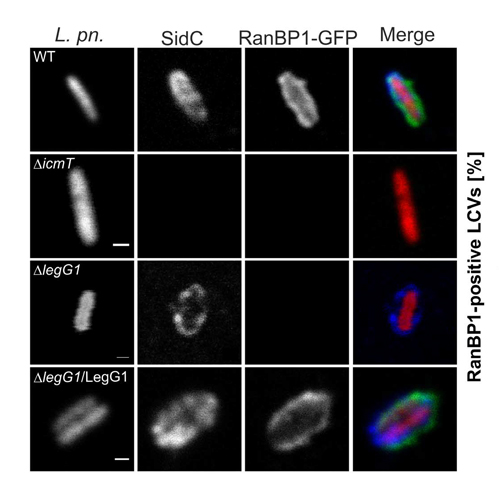Activation of Ran GTPase by a Legionella Effector Promotes Microtubule Polymerization, Pathogen Vacuole Motility and Infection
19-Sep-2013
PLOS Pathogens, 2013, DOI: 10.1371/journal.ppat.1003598, Volume 9, Issue 9, e1003598 published on 19.09.2013
The causative agent of Legionnaires' disease, Legionella pneumophila, uses the Icm/Dot type IV secretion system (T4SS) to form in phagocytes a distinct “Legionella-containing vacuole” (LCV), which intercepts endosomal and secretory vesicle trafficking. Proteomics revealed the presence of the small GTPase Ran and its effector RanBP1 on purified LCVs. Here we validate that Ran and RanBP1 localize to LCVs and promote intracellular growth of L. pneumophila. Moreover, the L. pneumophila protein LegG1, which contains putative RCC1 Ran guanine nucleotide exchange factor (GEF) domains, accumulates on LCVs in an Icm/Dot-dependent manner. L. pneumophila wild-type bacteria, but not strains lacking LegG1 or a functional Icm/Dot T4SS, activate Ran on LCVs, while purified LegG1 produces active Ran(GTP) in cell lysates. L. pneumophila lacking legG1 is compromised for intracellular growth in macrophages and amoebae, yet is as cytotoxic as the wild-type strain. A downstream effect of LegG1 is to stabilize microtubules, as revealed by conventional and stimulated emission depletion (STED) fluorescence microscopy, subcellular fractionation and Western blot, or by microbial microinjection through the T3SS of a Yersinia strain lacking endogenous effectors. Real-time fluorescence imaging indicates that LCVs harboring wild-type L. pneumophila rapidly move along microtubules, while LCVs harboring ΔlegG1 mutant bacteria are stalled. Together, our results demonstrate that Ran activation and RanBP1 promote LCV formation, and the Icm/Dot substrate LegG1 functions as a bacterial Ran activator, which localizes to LCVs and promotes microtubule stabilization, LCV motility as well as intracellular replication of L. pneumophila.











